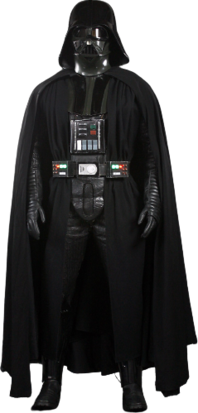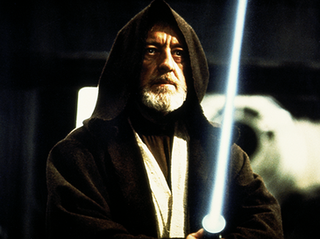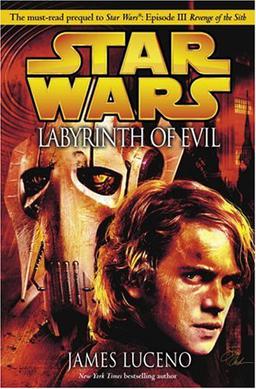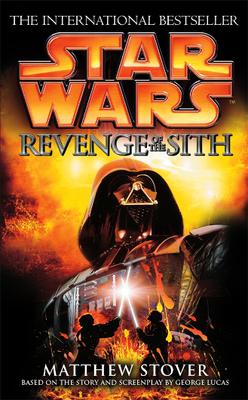Jedi, Jedi Knights, or collectively the Jedi Order are fictional characters, and often protagonists, featured in many works within the Star Wars franchise. Working symbiotically alongside the Old Galactic Republic, the Jedi Order is depicted as a religious, academic, meritocratic, and military (peacekeeping) organization whose origin dates back thousands of years before the events of the first film released in the franchise. The fictional organization has inspired a real-world new religious movement and parody religion: Jediism.

Luke Skywalker is a fictional character and the protagonist of the original film trilogy of the Star Wars franchise created by George Lucas. Portrayed by Mark Hamill, Luke first appeared in Star Wars (1977), and he returned in The Empire Strikes Back (1980) and Return of the Jedi (1983). Over three decades later, Hamill returned as Luke in the Star Wars sequel trilogy, with a cameo in The Force Awakens (2015) before playing a major role in The Last Jedi (2017) and The Rise of Skywalker (2019). He later played a digitally de-aged version of the character in the Disney+ series The Mandalorian, appearing in the second-season finale, which premiered in 2020, and The Book of Boba Fett, in the sixth episode, released in 2022.

Darth Vader is a character in the Star Wars franchise. He is the primary antagonist of the original film trilogy and, as Anakin Skywalker, is the protagonist of the prequel trilogy. Born a slave, he later becomes a powerful Jedi. He is lured to the dark side of the Force by Chancellor Palpatine, and becomes the Sith Lord Darth Vader. After being severely wounded in a lightsaber battle, he is transformed into a cyborg. He is the husband of Padmé Amidala and the biological father of Luke Skywalker and Leia Organa Solo.

Obi-Wan Kenobi is a fictional character in the Star Wars franchise. Within the original trilogy, Obi-Wan is a Jedi Master as a supporting character and is portrayed by English actor Alec Guinness. In the later-released prequel trilogy, a younger version of the character serves as one of the two main protagonists, alongside Anakin Skywalker, and is portrayed by Scottish actor Ewan McGregor. In the original trilogy he is introduced as Ben Kenobi, an alias he uses while in hiding from the Empire. He is a mentor to Luke Skywalker, to whom he introduces the ways of the Jedi. After sacrificing himself in a duel against Darth Vader, Obi-Wan guides Luke through the Force in his fight against the Galactic Empire. In the prequel trilogy, set two decades earlier, he is initially a Padawan (apprentice) to Jedi Master Qui-Gon Jinn, and later mentor and friend of Luke's father Anakin, who falls to the dark side of the Force and becomes Vader. The character briefly appears in the sequel trilogy as a disembodied voice, speaking to protagonist Rey, and serving as the namesake of Ben Solo. He is frequently featured as a main character in various other Star Wars media, including the streaming television miniseries Obi-Wan Kenobi, in which McGregor reprised the role.

Count Dooku of Serenno, also known by his Sith name Darth Tyranus, is a fictional character in the Star Wars franchise, created by George Lucas. He is an antagonist in the Star Wars prequel trilogy, appearing in both Episode II – Attack of the Clones (2002) and Episode III – Revenge of the Sith (2005), played by Christopher Lee, as well as associated media, such as books, comics, video games, and television series. Actor Corey Burton has voiced Dooku in most of his animated and video game appearances, most notably Star Wars: Clone Wars (2003–2005), Star Wars: The Clone Wars, and the miniseries Tales of the Jedi (2022). Lee reprised the role in the 2008 animated film that launched The Clone Wars series.

Qui-Gon Jinn is a fictional character in the Star Wars franchise, played by Liam Neeson. He is a main character in the prequel film trilogy, serving as one of the protagonists of The Phantom Menace (1999). He appears briefly as a Force ghost in the 2008 animated series The Clone Wars, the season finale of the 2022 live-action series Obi-Wan Kenobi, along with Attack of the Clones and The Rise of Skywalker as a disembodied voice, with Neeson reprising his role in all of the above. Qui-Gon also appears in two episodes of Tales of the Jedi, which depicts some scenes from his life before the events of The Phantom Menace; Neeson voices adult Qui-Gon in the series, while his son Micheál Richardson voices Qui-Gon as a padawan.

Yoda is a character in the Star Wars franchise. He is a small, green humanoid alien who is powerful with The Force. He is a Jedi Master and a leader in the Jedi Order. Frank Oz voiced and puppeteered Yoda in the 1980 film The Empire Strikes Back, which was the character's first appearance. Oz reprised the role in Return of the Jedi (1983), The Phantom Menace (1999), and The Last Jedi (2017). Yoda has also appeared in television series, comics, novels, video games and commercials. Outside of the films, the character has been voiced most frequently by Tom Kane.

The evil Galactic Empire, otherwise known as the Galactic Empire or simply as the Empire, is a fictional autocracy featured in the Star Wars franchise. It was first introduced in the 1977 film Star Wars and appears in its two sequels: The Empire Strikes Back (1980) and Return of the Jedi (1983). It is the main antagonistic faction of the original trilogy. An oppressive, autocratic regime with a complicated bureaucracy, the Galactic Empire seeks to ensure singular rule and social control over every planet and civilization within the galaxy.

The Skywalker family is a fictional legendary human family in the Star Wars franchise. Within the series' fictional universe, the Skywalkers are presented as a bloodline with strong inherent capabilities related to the Force and sometimes lightsaber skills. Luke Skywalker, his twin sister Princess Leia Organa, and their father Darth Vader are central characters in the original Star Wars film trilogy. Darth Vader, in his previous identity as Anakin Skywalker, is a lead character in the prequel film trilogy and so is his wife and the twins' mother Padmé Amidala; while his mother Shmi is a minor character in the first and second films respectively. Leia and Han Solo's son, Ben Solo, renamed himself Kylo Ren and is the main antagonist in the sequel film trilogy, while they and Luke serve as supporting characters. Shmi, Padmé, and Han are the only members who are not Force-sensitive. The Skywalker bloodline, alongside the Palpatine bloodline, are the two bloodlines that are the strongest with the Force.

"Duel of the Fates" is a musical theme recurring in the Star Wars prequel trilogy and the Expanded Universe. It was composed by John Williams and recorded for the film soundtrack of Star Wars Episode I: The Phantom Menace by the London Symphony Orchestra (LSO) and the London Voices. This symphonic piece is played with both a full orchestra and a choir. The lyrics are based on a fragment of an archaic Welsh poem Cad Goddeu, and are sung in Sanskrit. The piece debuts during the final lightsaber duel in Star Wars: Episode I – The Phantom Menace. With the music video for this theme, the LSO became the only classical group to ever have a video debut on MTV’s Total Request Live. "Duel of the Fates" lasted 11 days on the countdown.

Star Wars: Labyrinth of Evil is a 2005 novel by James Luceno set in the fictional Star Wars universe. The novel serves as a lead-in to Star Wars: Episode III – Revenge of the Sith, and was loosely adapted into Volume Two of the Star Wars: Clone Wars microseries.
Star Wars Infinities is a graphic novel trilogy published by Dark Horse Comics from 2002 to 2004. It tells a non-canon alternate version of each film in the original Star Wars trilogy in which a point of divergence occurs and changes the outcome of the story. Each individual Infinities story is unrelated to the others and is set within the timeline of their original film.

The music of the Star Wars franchise is composed and produced in conjunction with the development of the feature films, television series, and other merchandise within the epic space opera multimedia franchise created by George Lucas. The music for the primary feature films was written by John Williams. Williams' work on the series included the scores of nine feature films, a suite and several cues of thematic material for Solo and the theme music for the Galaxy's Edge Theme Park. These count among the most widely known and popular contributions to modern film music, and utilize a symphony orchestra and features an assortment of about fifty recurring musical themes to represent characters and other plot elements: one of the largest caches of themes in the history of film music.

Dark Lord: The Rise of Darth Vader is a novel set in the non-canonical Star Wars Legends continuity, written by James Luceno, that was published by Del Rey on November 22, 2005. Dark Lord takes place in the immediate aftermath of the events in Star Wars: Episode III – Revenge of the Sith, and focuses on Darth Vader and his rise to power in the newly inaugurated Galactic Empire.

Star Wars: Revenge of the Sith is a novelization of the film of the same name, written by Matthew Stover and published on April 2, 2005, by Del Rey Books.

The Sith are the main antagonists of many works in the fictional universe of the Star Wars franchise. They are the antithesis and ancient enemies of the Jedi. The Sith Order is depicted as an ancient cult of warriors who draw strength from the dark side of the Force and use it to seize power by any means necessary, including terrorism and mass murder; their ultimate goals are to destroy the Jedi and rule the galaxy. The various antagonistic factions in the franchise, namely the Confederacy of Independent Systems, the First Galactic Empire, the Imperial Remnant, and the First Order, all originated with the Sith. Sith, known individually as Sith Lords, are, by nature, ruthless. At any point a single individual assumes absolute authority amongst their kind and is granted the honorific Dark Lord of the Sith. Sith culture is based on perpetual treachery and betrayal. The fate of Sith Lords is, typically, to be murdered and replaced by their own apprentices. Sith teach their apprentices to revere the dark side of the Force, to give full reign to aggressive emotions such as rage and hatred, and to believe that others are expendable in the pursuit of power, it makes the Lords' demise inevitable.

Sheev Palpatine is a fictional character in the Star Wars franchise created by George Lucas. He first appears on screen in The Empire Strikes Back (1980), in which he is credited as The Emperor, and is the overarching antagonist of the three film trilogies in the Skywalker Saga, in which he is portrayed by Ian McDiarmid. The character is also known by his Sith name, Darth Sidious, which was first used in the novelization of The Phantom Menace (1999). In creating Palpatine, Lucas was inspired by real-world examples of democratic backsliding during the rise and rule of dictators such as Julius Caesar, Napoleon Bonaparte, and Adolf Hitler.

"Robot Chicken: Star Wars Episode II" is a 2008 episode of the television comedy series Robot Chicken, and the sequel to the Annie Award winning "Robot Chicken: Star Wars", which aired as a one-off special during Cartoon Network's Adult Swim block on November 16, 2008. Like "Robot Chicken: Star Wars", it has been released on its own DVD on July 21, 2009, and will not be part of a season box set. The DVD contains the original broadcast version, and the "Extended Version", which features an additional 15 minutes of footage cut from the broadcast version. It was nominated for a 2009 Primetime Emmy Award for Outstanding Animated Program.

Star Wars: A Galactic Spectacular was a nighttime show at Disney's Hollywood Studios in Walt Disney World. The show is based on the Star Wars film series and features fireworks, projection mapping, fire, lasers, fog effects, and searchlights. During the show, Star Wars imagery is projected onto the park's Chinese Theater facade and surrounding buildings around the park's hub on Hollywood Boulevard. The show had its celebrity-filled World Premiere on Friday, June 17, 2016, replacing the park's similarly-themed display, Symphony in the Stars: A Galactic Spectacular.

















